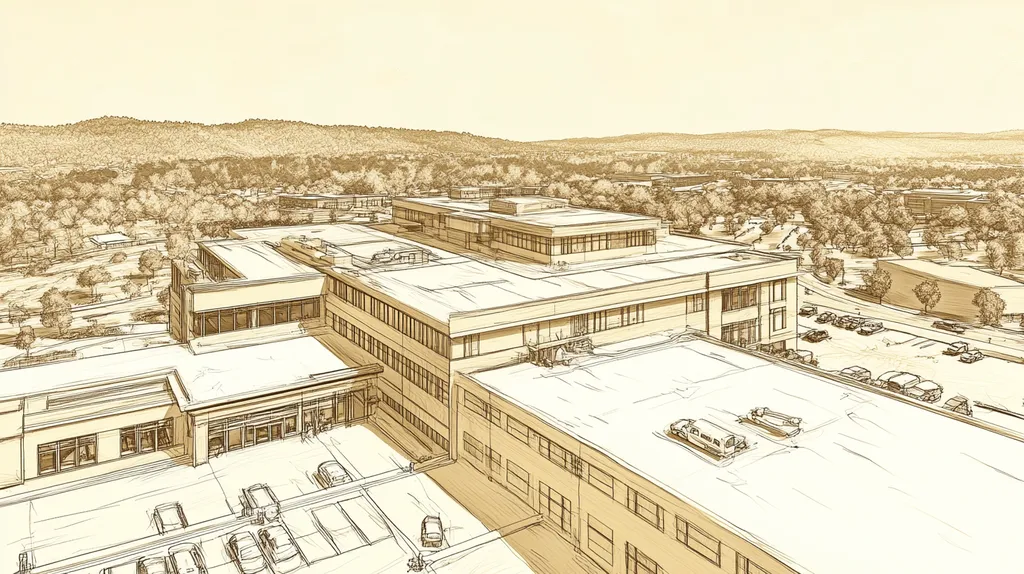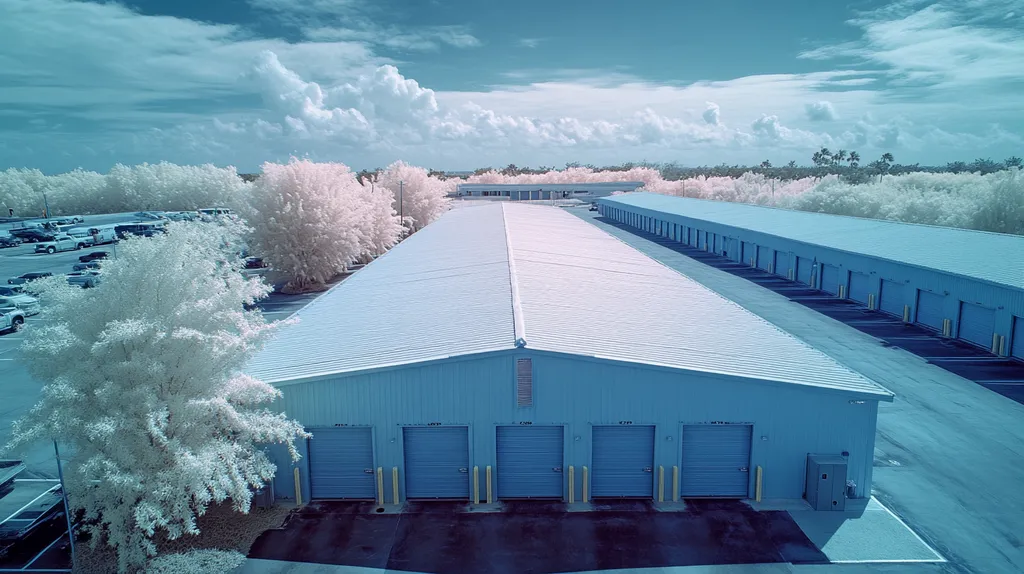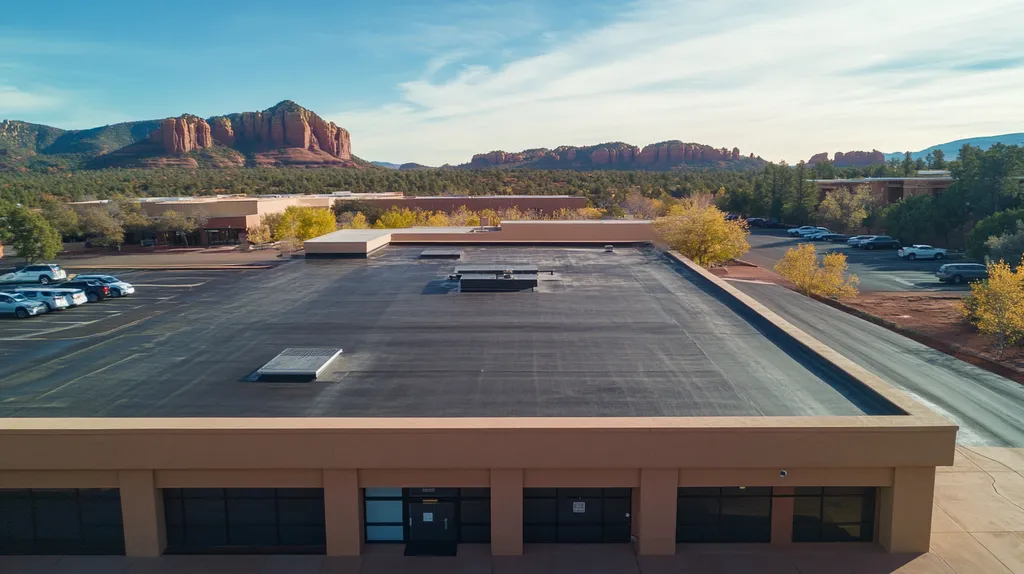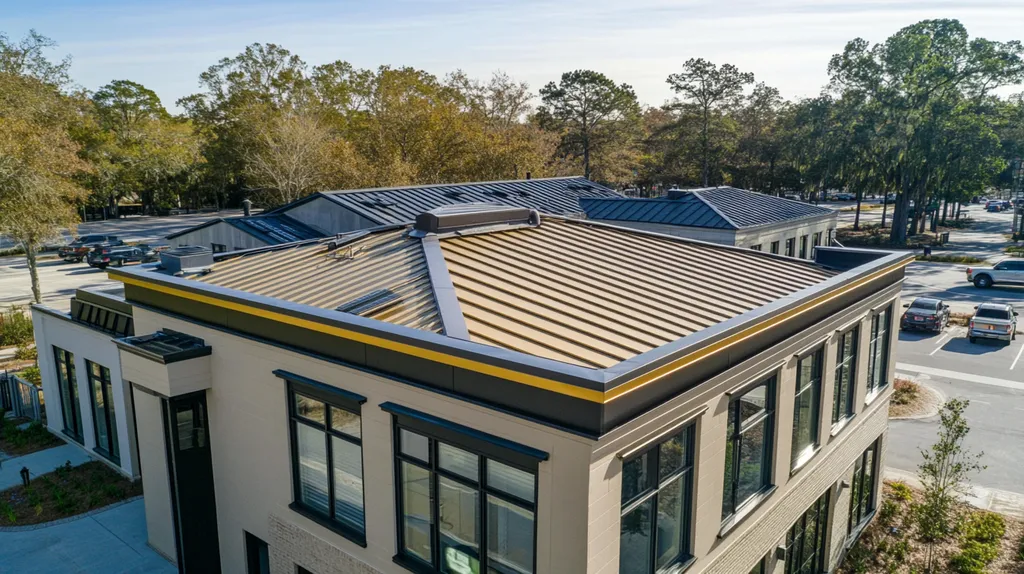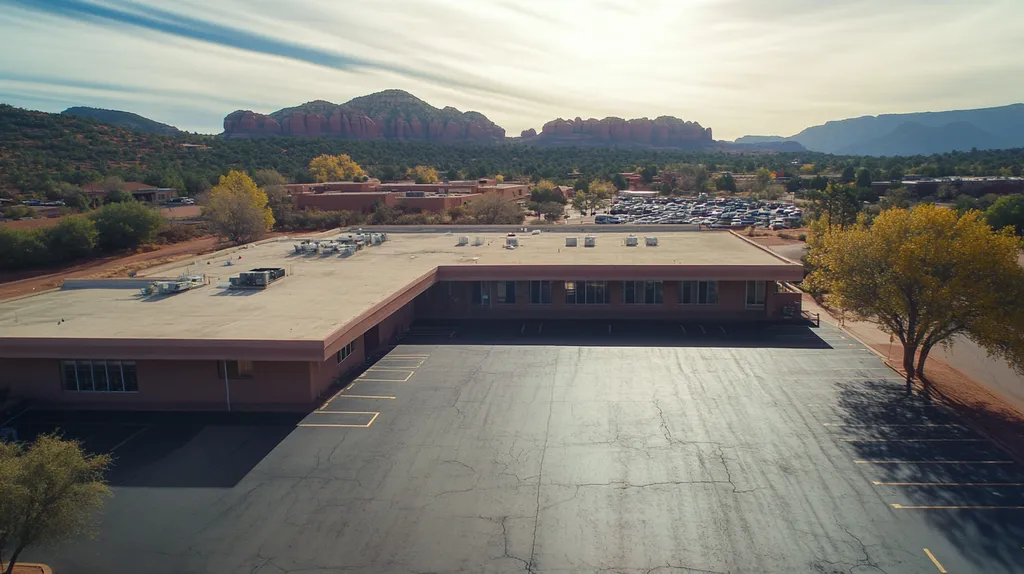Every year, industrial facilities waste millions in energy costs due to misconceptions about thermal emittance in roofing systems. Studies show that selecting the wrong roofing materials can inflate cooling expenses by up to 30% while accelerating deterioration of the entire system.
As energy prices continue climbing, property owners can no longer afford to ignore the critical role of thermal emittance in industrial roofing performance. The difference between high and low-emittance materials can impact not only operational costs but also building longevity and environmental compliance.
This comprehensive guide separates fact from fiction regarding thermal emittance, examining common myths, practical implications, and evidence-based solutions that facility managers need to make informed roofing decisions.
SECTION 1: COMMON MISCONCEPTIONS
Understanding thermal emittance is crucial for making smart roofing choices that impact your bottom line. Unfortunately, many property owners and facility managers cling to outdated beliefs that can restrict their ability to choose the most effective roofing systems. Misconceptions around materials and climate can seriously influence energy efficiency and operational costs. It’s high time to debunk these myths in order to unlock the full potential of roofing solutions.
Myth: Dark Roofs Are Always Inefficient
The common belief that dark roofs are universally inefficient is misleading. While lighter roofs do reflect more sunlight, dark roofs can be advantageous in certain climates. In colder regions, for example, dark materials absorb heat, creating warmer indoor environments and reducing heating costs.
Additionally, advancements in roofing technology have allowed for improved thermal emittance even in darker materials. Many modern dark roofs feature specialized coatings that boost their energy performance. Property owners should carefully evaluate these benefits in the context of their local climate conditions.
When selecting roofing systems, it is more beneficial to focus on the specific needs of the building rather than merely its color. Overlooking this nuance can lead to poor roofing choices and missed opportunities for energy savings.
Ultimately, superficial color alone should not dictate material selection. A deep understanding of thermal management principles is essential for achieving effective roofing outcomes.
Ignoring Climate Zone Specifics
One of the biggest errors in roofing decisions is the failure to account for the varying impacts of climate zones. Each region comes with its own unique challenges that can affect roofing performance. Properties in sunny, warm areas have different thermal needs compared to those located in cooler, overcast regions.
Choosing roofing materials tailored to the local climate is vital. For example, roofs in hot climates can gain significant advantages from reflective materials, while those in colder areas may perform better with darker materials that retain heat. Tailoring choices to geographic conditions is not just smart—it’s necessary.
Neglecting local climate specifics can lead to wasted energy and inflated operational costs. Without a strategic approach, businesses risk investing in roofing systems that miss the mark on efficiency.
By acknowledging these climate distinctions, property owners can select roofing systems that enhance energy performance. Ignoring these vital specifics can lead to long-lasting impacts on a facility’s energy efficiency and overall sustainability.
Overlooking Material Variations
The roofing industry offers a diverse range of materials, each with distinct thermal emittance properties, yet many property owners mistakenly assume that all materials of the same color perform similarly. This oversimplification can lead to poor roofing decisions.
For example, traditional asphalt might reflect heat less effectively compared to new polymer-modified bitumen options, which can also be dark. Grasping these material distinctions is crucial for selecting the best roofing product for each facility.
Incorporating high-emittance materials can significantly improve energy efficiency. Misunderstanding these variations can result in roofing that fails to meet energy performance expectations. A thorough evaluation of material options is essential for achieving the desired outcomes.
Property owners must resist the urge to make assumptions based solely on color or conventional wisdom. Conducting a detailed analysis of material properties will lead to better operational effectiveness and significant cost savings.
SECTION 2: PRACTICAL IMPLICATIONS
Thermal emittance is not just a technical detail; it’s a critical factor influencing industrial roofing decisions. With cooling costs consuming as much as 30% of energy expenses in commercial facilities, the selection of roofing materials can significantly impact financial performance. Low-emittance roofs worsen energy consumption and incur higher cooling costs, while high-emittance roofs can provide much-needed savings. This section will delve into how thermal emittance affects cooling costs, roof temperature, and the urban heat island effect, emphasizing the urgency for property owners and facility managers to address these issues.
Impact on Cooling Costs
The financial implications of a roof’s thermal emittance are profound. A roof with low thermal emittance retains heat, forcing HVAC systems to run longer and harder, which leads to skyrocketing energy costs. In contrast, a high-emittance roof reflects heat efficiently, lessening the burden on cooling systems.
A recent study by the U.S. Department of Energy found that buildings equipped with high-emittance roofs could enjoy cooling cost reductions of up to 20%. These savings translate directly into improved profitability for facilities operating in heat-intensive environments.
For property managers, prioritizing high-emittance roofing materials isn’t just a good practice—it’s a smart financial move. Enhanced emittance not only lowers energy bills but also helps extend the lifespan of cooling equipment, thereby slashing maintenance expenses.
Neglecting thermal emittance can result in lost revenue, reinforcing the importance of this factor in roofing decision-making. A proactive approach can protect a facility’s bottom line and contribute to sustainable energy consumption.
Effects on Roof Temperature
Understanding roof temperature is essential for controlling a building’s internal climate and energy efficiency. High thermal emittance materials are particularly effective in maintaining cooler roof temperatures, thereby reducing heat build-up, especially during peak summer months. This becomes crucial for industrial facilities housing equipment that generates significant heat.
By opting for high-emittance roofing materials, facilities have been documented to lower surface temperatures by as much as 30°F. This not only enhances worker comfort but also alleviates the strain on cooling systems, promoting improved operational efficiency.
In regions facing extreme heat, lower roof temperatures can prevent thermal expansion and contraction of roofing materials, extending their usable life. This durability translates into long-term savings and reduced replacement costs.
Therefore, property owners should strongly consider roofing systems that optimize thermal emittance as a means of ensuring better temperature regulation and overall energy performance.
Influence on Urban Heat Islands
Urban heat islands (UHIs) pose a significant challenge, particularly in cities with traditional roofing systems that absorb and retain heat. These areas can experience elevated air temperatures, increasing energy consumption and contributing to environmental issues. High-emittance roofing systems serve as a remedy by reflecting sunlight and emitting absorbed heat more effectively.
Research suggests that if commercial buildings particularly emphasized high-emittance materials, areas suffering from UHIs could experience temperature reductions of 5°F or more. Such decreases not only benefit the immediate environment but also lead to improved urban air quality.
For facility managers, integrating environmental considerations into roofing choices goes beyond aesthetics; it reflects a commitment to responsible energy use and community health. Addressing the impact of thermal emittance in roofing decisions is essential for promoting sustainability in urban environments.
Encouraging high thermal emittance in roofing practices is vital for fostering sustainable cities, making it crucial for industry leaders to champion and adopt better roofing methods.
SECTION 3: COST OF MISINFORMATION
The choices made in industrial roofing are often dictated by misinformation surrounding thermal emittance, with serious financial consequences. Studies reveal that miscalculating insulation values can inflate energy costs by as much as 30%. When property owners opt for the wrong materials or methods, they not only jeopardize their energy budget but also compromise their facility’s long-term sustainability. Grasping the fundamental role of thermal emittance is essential for making informed decisions that protect financial interests.
Increased Energy Expenditure
Underestimating the role of thermal emittance can have profound impacts on energy bills. Many property owners fail to see how this critical metric can drive up heating and cooling expenses. For instance, a facility with a low-emittance roof may experience skyrocketing energy bills during the hottest months of the year.
This spike in costs occurs because poorly designed roofs struggle to reflect heat effectively. When thermal emittance is low, roofs tend to absorb more heat, compelling air conditioning units to work overtime. Consequently, this can translate into tens of thousands of dollars wasted annually due to inefficient energy use.
As energy prices fluctuate, it becomes increasingly important for property managers to evaluate their roofing systems for thermal efficiency. By investing in materials with high thermal emittance, facilities can unlock substantial energy savings. The initial investment in better materials often yields significant returns over time, making it a smart financial decision.
In an era where operational efficiency is paramount, aligning roofing choices with thermal emittance considerations is not just an option—it’s a strategic move that can enhance the overall effectiveness of a facility.
Reduced Roof Lifespan
The longevity of a roofing system directly influences a property’s financial health. Misconceptions about thermal emittance can lead to poor material choices that don’t perform, resulting in premature roof failure. Low-emittance materials can accelerate wear and tear, necessitating replacements much sooner than expected.
For example, while a conventional industrial roof may last around 20 years, using incorrect materials influenced by misinformation can cut this lifespan in half. This leads to a cascade of unexpected expenses, including costs for replacement and additional labor.
A deteriorating roof can further impact real estate value. When properties show signs of neglect, potential buyers tend to shy away, which ultimately affects marketability. Well-informed decisions regarding thermal emittance can lead to roofing solutions that ensure durability and longevity, protecting the value of the investment.
Higher Maintenance Costs
Misinformation about thermal emittance can also escalate maintenance costs, placing additional burdens on facility budgets. Assumptions made about roofing materials often result in unanticipated wear and tear, leading to frequent maintenance requests. Each unplanned repair not only drains resources but can disrupt regular operations as well.
For instance, properties may suffer from increased leaks or damages due to poor heat management. These repairs incur unexpected capital expenditure, diverting funds from other essential projects and stretching maintenance budgets thin.
Moreover, less efficient roofs necessitate more frequent service calls. As roofs decline, property managers often find themselves reacting to issues rather than taking a proactive approach to maintenance. By prioritizing accurate thermal emittance information, managers can curb these risks effectively.
In summary, misinformation regarding thermal emittance exacerbates financial strain through rising maintenance and repair costs. To optimize performance and safeguard the value of their facilities, property owners must prioritize accurate, reliable information in their roofing decisions.
SECTION 4: REALITY CHECK
The stakes surrounding thermal emittance in industrial roofing are higher than ever, particularly when it comes to operational costs and environmental responsibility. Studies indicate that reflective surfaces can slash cooling costs by an impressive 10-15%, yet many property owners remain unaware of how their roofing choices directly impact energy consumption. Ignoring the interplay of solar reflectance, thermal emittance, and Solar Reflectance Index (SRI) values can result in inflated energy bills and accelerated roof deterioration. Understanding these elements is essential for making informed, cost-effective roofing decisions.
Understanding Solar Reflectance
Solar reflectance measures the effectiveness of a roofing surface in bouncing back sunlight. The higher the solar reflectance, the less heat a roof absorbs, which translates into lower cooling expenses. For instance, a white, reflective roof can boast a solar reflectance rating above 0.80, whereas a traditional dark roof might reflect only 0.05 or even less.
This dramatic contrast leads to significant differences in internal building temperatures and energy usage. Importantly, roofs with elevated solar reflectance often enjoy longer lifespans, ultimately lowering replacement costs. Therefore, prioritizing solar reflectance is critical for property owners focused on maximizing cost efficiency and sustainable practices.
Geographic location plays a crucial role in evaluating solar reflectance. In hotter climates, reflective roofs can drastically reduce the demand for air conditioning. Choosing the right roofing material based on solar reflectance can be a savvy long-term investment.
Finally, property owners should engage with roofing professionals who understand these characteristics. The decision on roofing material is not just about aesthetics; it carries substantial financial implications.
The Role of Thermal Emittance
Thermal emittance quantifies a material’s ability to radiate absorbed heat. A roof with high thermal emittance excels at releasing heat back into the atmosphere, cooling more effectively. This property intersects closely with solar reflectance, creating a comprehensive overview of thermal performance.
For example, a roofing system that combines strong solar reflectance with high thermal emittance is particularly effective for mitigating urban heat islands. This efficiency results in reduced electricity consumption and lower greenhouse gas emissions. High-emittance materials, such as specific types of PVC or TPO membranes, are gaining traction in industrial applications for these reasons.
Moreover, opting for materials with good thermal emittance can enhance the performance of renewable energy options like rooftop solar panels. This harmonization improves energy efficiency, further lowering costs for facility managers.
Therefore, it’s crucial that property owners consider thermal emittance ratings during their roofing material selection. This focus not only impacts energy efficiency but also affects workplace comfort levels.
Importance of SRI Values
The Solar Reflectance Index (SRI) consolidates both solar reflectance and thermal emittance into a single performance metric for roofing materials. A higher SRI reflects superior capability in combating heat absorption, thereby boosting energy efficiency.
For example, a roofing system with an SRI over 82 can yield cooling savings near 15% compared to conventional materials. This could translate into substantial energy savings over time, underscoring the criticality of SRI in roofing decisions.
Moreover, many municipal codes and sustainability initiatives factor in SRI values, influencing compliance with regulations and potential eligibility for financial incentives. As the demand for green building practices increases, SRI metrics will likely become a standard consideration in roofing evaluations.
Incorporating SRI values into the roofing selection process is vital for achieving environmental goals while optimizing capital expenditures. This thoughtful approach maximizes both financial returns and ecological benefits for industrial property owners.
SECTION 5: EVIDENCE-BASED ALTERNatives
The choice of roofing materials is more than just an aesthetic consideration; it plays a critical role in energy efficiency and long-term operational costs for industrial facilities. Inadequate thermal emittance can lead to excessive heat absorption, prompting higher air conditioning demands and escalating operational expenses. As energy prices continue to rise, property owners must pivot toward evidence-based alternatives that tackle heat build-up effectively and enhance overall building performance. This section explores high-emittance roofing materials, cool metal roofing solutions, and reflective coatings to combat thermal issues.
High-Emittance Roofing Materials
High-emittance roofing materials are engineered to reflect heat during the day while efficiently releasing it at night. These innovative materials can dramatically lower roof temperatures, aiding in the reduction of the urban heat island effect. Examples include specialized single-ply membranes that achieve emittance values above 0.9, indicating they are 90% effective at emitting heat.
Implementing these materials not only enhances indoor comfort but also extends the lifespan of the roofing system. By diminishing reliance on air conditioning, facilities can realize significant savings on energy bills. Research shows that a facility using high-emittance roofing can experience temperature reductions of 10-15 degrees Fahrenheit on its roof surface.
Moreover, this transition fosters sustainability by lowering overall energy consumption, which positively impacts the environment by reducing greenhouse gas emissions linked to energy production. Property owners should verify performance ratings and compliance with local building codes when selecting high-emittance materials. Consulting with a roofing expert will ensure informed and effective choices.
Cool Metal Roofing Solutions
Cool metal roofing has emerged as a highly effective solution for managing roof temperatures. These roofs are coated with reflective materials that outperform traditional roofing options in sunlight reflection. Research indicates that cool metal roofing can lower roof surface temperatures by as much as 30% compared to darker materials.
This temperature reduction leads to decreased cooling energy costs. Facilities equipped with cool metal roofs often report savings of 10-20% on air-conditioning expenses during peak summer months, translating into substantial annual savings for large industrial facilities.
In addition to financial benefits, cool metal roofs support sustainability initiatives by reducing energy use and minimizing heat emissions. As cities increasingly endorse cool roofing solutions within their urban heat island mitigation strategies, this option becomes particularly relevant for facility managers focusing on regulatory compliance and community impact.
Furthermore, cool metal roofing offers durability, as metal usually outlasts many traditional roofing materials. This combination of performance and lifespan makes cool metal roofs an intelligent investment for facility owners looking to enhance their roofing choices.
Reflective Coatings and Treatments
Reflective coatings present an innovative, cost-effective approach to enhance traditional roofing systems. These coatings can be applied to a variety of roofing materials, transforming them into high-performance thermal barriers. By efficiently reflecting incoming solar radiation, these treatments can lead to significant reductions in roof temperatures.
For example, a facility that applies reflective coatings can achieve temperature drops of up to 30 degrees, leading to reduced cooling demands. This advantage contributes to cost savings and enhances indoor comfort for occupants, fostering a better work environment.
Additionally, reflective coatings help extend the life of existing roofs by shielding them from UV rays and environmental wear. Many of these coatings boast high emittance values, ensuring that roofs can efficiently release absorbed heat and enhance thermal performance.
These coatings may also qualify for energy-efficiency incentives or rebates, making them an appealing choice for budget-conscious property owners. Proper application by certified professionals guarantees that the durability and effectiveness of the coatings are maximized, effectively improving the performance of existing roofing systems.
SECTION 6: TEST AND VERIFY
In the world of industrial roofing, understanding thermal emittance is more than a technical detail—it’s a financial imperative. With energy costs rising, making informed roofing choices can translate to significant cost savings or unplanned expenses over time. It’s critical to test and verify thermal emittance to ensure effective energy management. This section delves into the CRRC certification process, practical methods for measuring thermal emittance, and the importance of compliance with energy codes.
CRRC Certification Process
The Cool Roof Rating Council (CRRC) is integral to setting reliable thermal emittance standards for roofing materials. Their rigorous certification process assesses roofing products based on specific performance criteria, ensuring that property owners can trust the products they choose.
When a material receives CRRC certification, it earns a score that reflects its ability to reflect solar energy and effectively emit thermal energy. This transparency aids facility managers in making informed purchases. Moreover, selecting CRRC-certified products can lead to compliance with energy efficiency programs, thereby advancing sustainability objectives.
Additionally, using these certified materials can qualify building owners for rebates and incentives during retrofitting. This financial advantage makes it critical for facility managers to prioritize CRRC-certified materials to optimize their buildings’ energy performance.
Measuring Thermal Emittance
To validate a roofing material’s performance, measuring thermal emittance is essential. This typically involves conducting laboratory tests under controlled conditions to guarantee accuracy and reliability. By adhering to standardized methods, industry professionals can obtain trustworthy data about a roofing system’s long-term effectiveness.
One popular technique is infrared thermography, which allows for immediate assessments of heat absorption and release in roofing materials. This on-site verification tool aids in confirming whether a roofing system meets energy efficiency expectations.
Consistent and standardized testing is vital; any deviation can lead to misleading data. Inaccurate measurements not only misguide property owners but also jeopardize compliance with important energy codes and regulations.
Compliance with Energy Codes
Compliance with energy codes is crucial for any industrial property. These regulations are designed to ensure that building owners meet minimum efficiency requirements that benefit both the environment and their operational expenses. Many jurisdictions impose specific mandates that include thermal emittance standards.
Failure to adhere to these codes can result in increased operational costs and the risk of fines. Property owners must stay abreast of the latest energy regulations that affect their facilities to avoid unnecessary expenses. Regular audits and assessments are essential for maintaining compliance and optimizing the performance of roofing systems.
Moreover, proper documentation of a roofing system’s thermal emittance is fundamental for compliance. This information underpins energy efficiency claims and is often necessary for obtaining permits or financing. By prioritizing compliance, facility managers not only meet regulatory demands but also position their properties for long-term success in managing energy efficiently.
The Bottom Line
With industrial facilities wasting up to 30% of their energy costs due to poor thermal emittance choices, the stakes couldn’t be higher for property owners and facility managers.
The evidence is clear: properly selected high-emittance roofing materials can reduce cooling costs by 10-20% while extending roof lifespans by decades.
Understanding and implementing proper thermal emittance solutions isn’t just about regulatory compliance – it’s about protecting millions in business assets and operational costs.
As energy prices continue rising and urban heat islands intensify, facility managers must prioritize thermal emittance in their roofing decisions or risk facing escalating expenses and premature system failures.
The future of industrial roofing lies in evidence-based solutions that optimize both performance and sustainability through proper thermal management.
FREQUENTLY ASKED QUESTIONS
Q. Is it true that dark roofs are always inefficient for a commercial roof?
A. This belief is misleading. Dark roofs can absorb heat in colder climates, enhancing energy efficiency. Modern advancements also allow dark roofs to maintain effective thermal emittance, balancing both heat absorption and emission qualities depending on local climate conditions.
Q. How does thermal emittance affect cooling costs for an industrial roof?
A. A roof’s thermal emittance plays a significant role in energy expenses. Low-emittance roofs retain heat, causing HVAC systems to consume more energy. Choosing high-emittance materials can reduce cooling costs by up to 20%, enhancing financial performance for industrial facilities.
Q. What financial consequences arise from misinformation about industrial roofs’ thermal emittance?
A. Misunderstanding thermal emittance can inflate energy bills and reduce roof lifespan. Low-emittance roofs lead to greater energy consumption, increasing operational costs significantly. This can translate to tens of thousands wasted annually, emphasizing the need for informed roofing decisions.
Q. How do solar reflectance and thermal emittance impact a commercial roof?
A. Both metrics are essential for energy efficiency; high solar reflectance keeps roofs cooler, while high thermal emittance effectively radiates heat. Together, they lower internal temperatures, reduce cooling costs, and extend roof lifespan, ultimately benefiting facility management.
Q. What are the best evidence-based alternatives for improving thermal management?
A. High-emittance roofing materials, cool metal roofs, and reflective coatings are excellent alternatives. These solutions help limit heat absorption and manage energy costs. Facilities that adopt these approaches can significantly reduce cooling demands and enhance overall performance.
Q. How is thermal emittance tested and verified for a commercial roof?
A. Thermal emittance is typically validated through standardized tests, including infrared thermography. Following certification processes like CRRC ensures that roofing materials meet performance criteria, allowing property owners to trust their energy efficiency and compliance with regulations.
Q. What other factors should I consider when selecting an industrial roof?
A. Besides thermal emittance, consider factors such as insulation, local climate, and building regulations. It’s crucial to evaluate the long-term durability, maintenance requirements, and costs associated with different roofing materials. Consulting with experts can ensure informed choices that maximize efficiency and performance.

